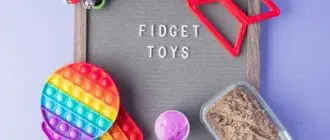I remember being in the middle of a stormy sea once. Our boat captain expertly steered us away from the scary, tumultuous waves and we were able to find refuge on a mountainous, rock island.
But then…
We couldn’t dock on the island itself but could only anchor the boat where the wind was calmer to keep us from being swept back into the wild waters.
An anchor chart in a classroom does the same thing, it is an artifact that helps both teachers and students stay on track and grounded amidst raging distractions and whirls of confusing ideas.
But What Are Anchor Charts, Exactly?

They present the essential points of a lesson—an anchor point that students can refer back to, to reinforce prior learning or as a guide during independent work.
They are made to emphasize or highlight key concepts, processes, or skills that students need to learn.
They are created during instruction. As the teacher conducts the lesson through think-aloud modeling, important points are then written on chart paper.
After the lesson, you can place the charts for a period of time in a prominent place in the classroom to serve as an exemplar of what the students’ outcomes should look like. It is important to note that anchor charts are supposed to be dynamic, living artifacts in the classroom. They should be often referred back to and elaborated upon throughout a unit of study or even the school year.
What Are the Types of Anchor Charts?
You can literally find thousands of anchor chart examples on Pinterest and Google. This can make searching for the one you really need a bit of a challenge. But basically, all these charts can be categorized into three types:
Ritual or Procedural Anchor Charts

For example, a chart showing the format of how students should answer during recitations can be fixed on a classroom wall to encourage students to always answer in complete sentences.
Toolbox Anchor Charts
This type of visual aid helps support students when they struggle to remember a step-by-step process.
For example, a chart containing sequence words can help students make sentences with more ease during a lesson about giving instructions.
Content Anchor Charts
This type usually serves as a cheat sheet that allows students to approach their work with a strategy.
They are used to further enhance understanding of a new lesson or to help students deal with the tricky areas that may be causing them confusion. For example, a chart showing the different parts of a plot can help students analyze a story independently.
The Value of Anchor Charts
For what purpose is an anchor chart, you ask? Well, various researches show that anchor charts are invaluable to classroom learning because of the following:
- They are visual tools that help guide learners throughout lessons.

According to a pilot study that focused on how students perceive visuals, most students need to see things to learn. Learners in the study have claimed that visuals add a detailed experience to learning and bring another way to hear and see the information.
- They give students a sense of ownership.
Taking part in creating anchor charts with you can give them pride in the work they have done.
- They are engaging.
Having something to look at to remember the details they have forgotten can help trigger memories and cement learning.
- They can encourage students to review prior learning.
When learners are part of creating an anchor chart, they are more likely to refer back to it as they complete independent work.
- They help teachers to work smart.
Creating anchor chart templates can help streamline your time preparing for lessons. It will also enable you to reach various grade levels and different proficiency levels with little customizing of materials for each.
- They also serve as a record of your instruction.
When Should You Use Anchor Charts?
For Whole Group Discussions
This way, everyone can have a starting place as the teacher models active think-aloud strategy to help guide the students’ thought processes.
For example, a chart explaining how to infer the central message, theme, and lesson from a text can help students identify these concepts in various materials such as stories, fables, and poems. You can ask students to stick post-it notes to the chart to make it interactive.
For Small Group Discussions
Small groups can use anchor charts to review what they have learned.
The same anchor chart cited above can be looked at repeatedly to guide a small group discussion. If there are concepts that are confusing, you can add those precautions to the chart and that will help redirect students to the right path.
As a Guide During Independent Work
An anchor chart posted in the classroom can serve as an exemplar for students to use as they complete independent tasks.
It’s a mighty tool for encouraging independent learning and can help hone their problem-solving skills.
As a Cheat Sheet
Other anchor charts can be given as handouts that students can review anytime.
This promotes further independence and helps students take charge of their own learning.
How to Create and Best Present an Anchor Chart
- First, decide on a title.
Make it brief and concise. This will help students quickly identify the chart when they need it for later reference.
- Then, prepare your introduction.
This element does not visually appear in the chart, but it’s important to prepare this beforehand. As much as possible, trigger students’ background knowledge on the topic by eliciting answers. At the end of your introduction, students should have an idea of what to expect and what the topic will be about.
- Next, create a simple drawing.
This will provide students with a visual representation of the new information being presented, making it easier to remember. Those pictures in their minds will serve as the entry point into learning. This is the ideal time to include the key points you want to stress and establish the lesson goals. New vocabulary words should also be introduced and explained in this part.
- Lastly, leave room in the chart for students to participate or fill in the blanks.
For your anchor chart to be truly effective, the majority of it needs to be created with the students. Engage and encourage them to participate and have ownership of their learning process. The unique, sometimes humorous touches they provide will make your anchor charts more memorable.
What Is an Interactive Anchor Chart?
Anchor charts serve not only as a visual guide but can also be a breathing, living part of learning.
It is most effective when students are able to interact and actively participate in the completion of it.
Students can help fill in the blanks in an anchor chart, generating answers in real-time as the teacher conducts the lesson using active think-aloud modeling.
How to Make Any Anchor Chart Interactive
Deliberately making anchor charts as interactive as possible will set your students up for success. Here are some ideas you can try to make your charts more collaborative.
Use QR Codes
If you’d like students to view a video or image online as an additional resource, you can use the QR Code Generator website to generate codes for your anchor chart. The students can then use their smartphones to take pictures of the codes and that will take them to the web addresses you’ve provided.
Simple copy and paste the link of a video or image into the website and a QR code will be generated for you to download.
For example, an art teacher can paste pictures of QR codes on chart paper to show learners different YouTube videos of various painting techniques.
Make Use of Post-it Notes
Use post-it notes to add the students’ answers to the anchor chart. For example, a literature teacher can ask students about the key points of a plot, then students write their answers on post-it notes, stick them to the chart paper, and the teacher can draw lines to represent plot progression.
You can also use them to color code words into categories. For example, a teacher can ask English language learners to differentiate between nouns, verbs, and adjectives by saying the right color of post-it notes before sticking them on the anchor chart. This activity will help students master target vocabulary words and is also a fun way of keeping them awake through physical activity.
Make a Group Anchor Chart
Simply prepare an anchor chart with clear headings and let the students fill the blank spaces with their answers. For example, a biology teacher can ask students to write examples of animals belonging to a specific animal kingdom in an anchor chart.
Jump In: Students could use markerspace materials for the creation of their anchor charts! Learn more about this by reading my post here — Top 19 Makerspace Materials to Enliven and Enrich Creative Learning.
Characteristics of Excellent Anchor Charts
I’d love for you to make only the best anchor charts, so here are helpful tips that can guide you in creating excellent, engaging, and effective ones.
- It should only contain key, essential information.
Focus on key vocabulary words related to the topic and keep texts as short as possible.
- It should be organized and uncluttered.
Icons and graphics should be simple and clear.
- It should be easily visible.
Use dark tones for your texts and use lighter colors at a minimum (preferably only for accents).
- It should be clearly labeled.
Create anchor charts with clear, specific headings. For example, if you’re a history teacher teaching about a specific event, label your anchor chart as such (e.g. The Vietnam War) and not something more general.
- It should be placed in the right location.
Make sure to choose the most optimal places for your charts. For example, an art teacher can place a painting anchor chart near the sink where the students get their water and paintbrushes. A literature teacher can place a chart about book genres next to the classroom library.
- It should be visually engaging.
Make sure that they are easy to read and understand by keeping fonts and pictures the right size and color. Elements should not be distracting and should only serve to add to the chart’s usefulness.
- It should be repeatedly used.
Students have the tendency to eventually ignore and forget something that’s always in front of them, so make sure to remind students about the anchor charts available in the room. After all, anchor charts are only useful if the students are using them as references.
- It should only reflect the most useful content.
Remove charts that have outlived their usefulness. Too much clutter in the classroom can distract learners. Make sure to rotate and only display the ones that students actually need. With this strategy, anchor charts will stay interesting and fresh to your learners.
Fun Fact: Anchor charts could be used as part of your memorable first-week activity! Read more about other memorable class activities by going here — 11 Memorable First Week of School Activities That Are So Much Fun.
——————————
Frequently Asked Questions
What if I run out of space in the classroom?
Here’s a space-saving idea, laminate your charts and fasten them together through a removable pocket ring or hanger. This way, all your charts are in one place, you just have to flip through the pages to find the one you need.
How do I keep track of the anchor charts I’ve made?
Have a master notebook of your anchor charts. You can take photos of them and keep them in a binder.
How do I hang the anchor charts?
It really depends on your classroom wall. I usually use Blu Tack, a reusable adhesive. It holds well and lasts long too.
Final Thoughts
Anchor charts are invaluable classroom tools because it makes both your and your students’ thoughts visible. They don’t only anchor your topic, they make them come to life. As a last tip, here’s a gentle reminder: Anchor charts are not worksheets. When used repeatedly in the same way, they can lose their novelty and become just another task that students need to accomplish.
Make sure to engage your students in conversation, negotiation, and mutual decision-making as you present an anchor chart. This way, your anchor charts will always create a lasting impression, adding the most value to your learners.
Last Updated on July 24, 2022 by Emily
- Facebook9
- Twitter21
- Pinterest67
- 97shares




